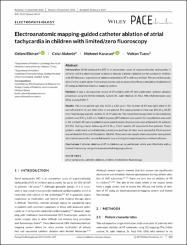| dc.contributor.author | Elkıran, Özlem | |
| dc.contributor.author | Akdeniz, Celal | |
| dc.contributor.author | Karacan, Mehmet | |
| dc.contributor.author | Tuzcu, Volkan | |
| dc.date.accessioned | 10.07.201910:49:13 | |
| dc.date.accessioned | 2019-07-10T19:49:38Z | |
| dc.date.available | 10.07.201910:49:13 | |
| dc.date.available | 2019-07-10T19:49:38Z | |
| dc.date.issued | 2019 | en_US |
| dc.identifier.citation | Elkıran, Ö., Akdeniz, C., Karacan, M. ve Tuzcu, V. (2019). Electroanatomic mapping-guided catheter ablation of atrial tachycardia in children with limited/zero fluoroscopy. Pace-Pacing and Clinical Electrophysiology, 42(4), 453-457. https://dx.doi.org/10.1111/pace.13619 | en_US |
| dc.identifier.issn | 0147-8389 | |
| dc.identifier.issn | 1540-8159 | |
| dc.identifier.uri | https://dx.doi.org/10.1111/pace.13619 | |
| dc.identifier.uri | https://hdl.handle.net/20.500.12511/1687 | |
| dc.description | WOS: 000462873900008 | en_US |
| dc.description | PubMed ID: 30740745 | en_US |
| dc.description.abstract | Introduction Atrial tachycardia (AT) is an uncommon cause of supraventricular tachycardia in children and it is often resistant to medical therapy. Catheter ablation can be curative in children with AT. However, experience of ablation of pediatric AT is still very limited. The aim of this study, which is the largest series from a single center, was to assess the efficacy and safety of ablation of AT using an electroanatomical-mapping system. Methods It was a retrospective review of 39 children with AT who underwent catheter ablation procedure using the EnSite Velocity system (St. Jude Medical, St. Paul, MN, USA) between July 2012 and April 2017. Results The mean patient age was 13.32 +/- 6.82 years. The location of AT was right sided in 25 and left sided in 13, and both sides in one patient. The mean procedure time was 184.23 +/- 60.19 min. Fluoroscopy was not used in 25 of 39 patients. The mean fluoroscopy time in the remaining patients was 5.53 +/- 5.22 min. Radiofrequency (RF) ablation was used in 22, cryoablation was used in 10, and both RF and cryoablation were used in seven. Acute success was achieved in 34 patients (87.2%). During a mean follow-up of 51.35 +/- 12.62 months, AT recurred in five patients. These patients underwent second ablation procedures and four of them were successful. Final success was achieved in 33 out of 39 patients (84.6%). There were no complications except for one patient who had an uneventful pericardial needle injury during transseptal puncture without effusion. Conclusions Catheter ablation of AT in children can be performed safely and effectively with a limited fluoroscopy using electroanatomical mapping systems. | en_US |
| dc.description.sponsorship | Medipol University | en_US |
| dc.description.sponsorship | This work was supported by Medipol University through its institutional facilities. | en_US |
| dc.language.iso | eng | en_US |
| dc.publisher | Wiley | en_US |
| dc.rights | info:eu-repo/semantics/embargoedAccess | en_US |
| dc.subject | Atrial Tachycardia | en_US |
| dc.subject | Catheter Ablation | en_US |
| dc.subject | Children | en_US |
| dc.subject | Limited | en_US |
| dc.subject | Zero Fluoroscopy | en_US |
| dc.title | Electroanatomic mapping-guided catheter ablation of atrial tachycardia in children with limited/zero fluoroscopy | en_US |
| dc.type | article | en_US |
| dc.relation.ispartof | Pace-Pacing and Clinical Electrophysiology | en_US |
| dc.department | İstanbul Medipol Üniversitesi, Tıp Fakültesi, Dahili Tıp Bilimleri Bölümü, Çocuk Sağlığı ve Hastalıkları Ana Bilim Dalı | en_US |
| dc.authorid | 0000-0002-8647-6055 | en_US |
| dc.authorid | 0000-0002-4375-2881 | en_US |
| dc.authorid | 0000-0001-9008-4997 | en_US |
| dc.identifier.volume | 42 | en_US |
| dc.identifier.issue | 4 | en_US |
| dc.identifier.startpage | 453 | en_US |
| dc.identifier.endpage | 457 | en_US |
| dc.relation.publicationcategory | Makale - Uluslararası Hakemli Dergi - Kurum Öğretim Elemanı | en_US |
| dc.identifier.doi | 10.1111/pace.13619 | en_US |
| dc.identifier.wosquality | Q4 | en_US |
| dc.identifier.scopusquality | Q2 | en_US |


















